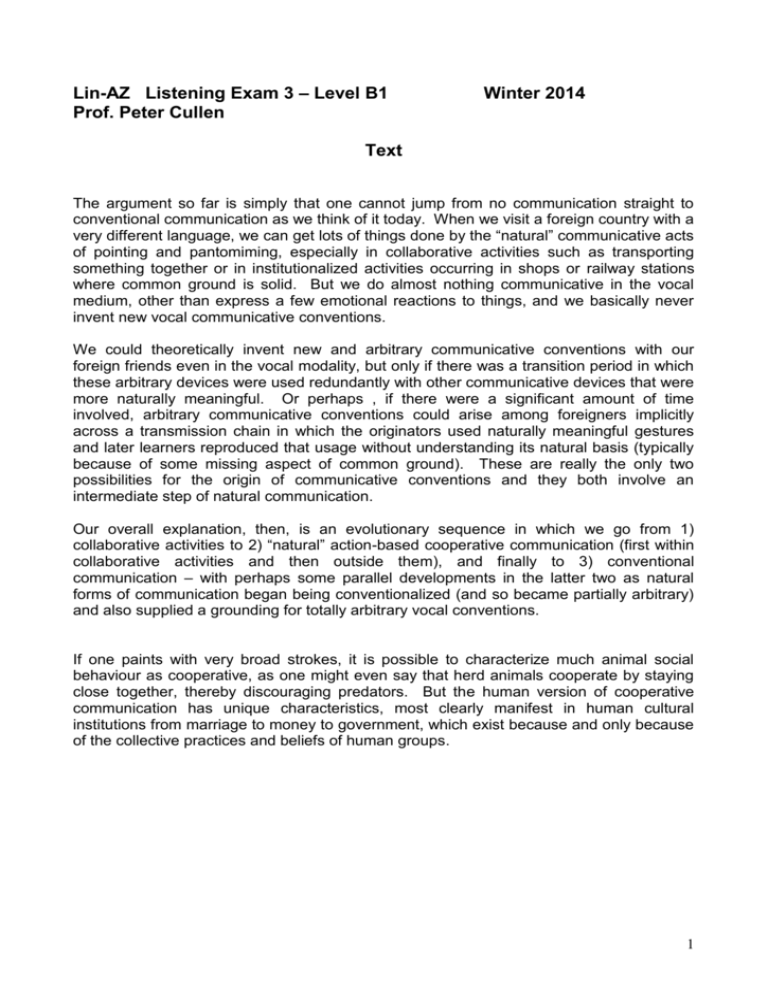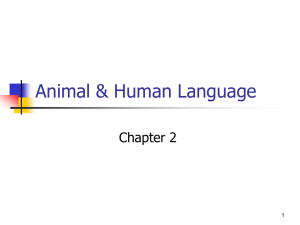LAZ B1 Listening Exam 3 01 2014
advertisement

Lin-AZ Listening Exam 3 – Level B1 Prof. Peter Cullen Winter 2014 Text The argument so far is simply that one cannot jump from no communication straight to conventional communication as we think of it today. When we visit a foreign country with a very different language, we can get lots of things done by the “natural” communicative acts of pointing and pantomiming, especially in collaborative activities such as transporting something together or in institutionalized activities occurring in shops or railway stations where common ground is solid. But we do almost nothing communicative in the vocal medium, other than express a few emotional reactions to things, and we basically never invent new vocal communicative conventions. We could theoretically invent new and arbitrary communicative conventions with our foreign friends even in the vocal modality, but only if there was a transition period in which these arbitrary devices were used redundantly with other communicative devices that were more naturally meaningful. Or perhaps , if there were a significant amount of time involved, arbitrary communicative conventions could arise among foreigners implicitly across a transmission chain in which the originators used naturally meaningful gestures and later learners reproduced that usage without understanding its natural basis (typically because of some missing aspect of common ground). These are really the only two possibilities for the origin of communicative conventions and they both involve an intermediate step of natural communication. Our overall explanation, then, is an evolutionary sequence in which we go from 1) collaborative activities to 2) “natural” action-based cooperative communication (first within collaborative activities and then outside them), and finally to 3) conventional communication – with perhaps some parallel developments in the latter two as natural forms of communication began being conventionalized (and so became partially arbitrary) and also supplied a grounding for totally arbitrary vocal conventions. If one paints with very broad strokes, it is possible to characterize much animal social behaviour as cooperative, as one might even say that herd animals cooperate by staying close together, thereby discouraging predators. But the human version of cooperative communication has unique characteristics, most clearly manifest in human cultural institutions from marriage to money to government, which exist because and only because of the collective practices and beliefs of human groups. 1 Lin-AZ Listening Exam 3 – Level B1 Winter 2014 ______/30 Prof. Peter Cullen ___________________________________________ Name, Date, and Registration Number Questions: You do not have to use complete sentences! This is a listening exam. SIMPLE AND CORRECT IS BETTER THAN COMPLICATED AND WRONG. 1. What is the argument so far? 2. What do we do in the vocal medium when we visit a foreign country with a very different language? 3. What could arise among foreigners if there were a significant amount of time involved? 4. What do the two possibilities for origins of communicative conventions both involve? 5. What characteristic is unique to human communication? ______/20 True or False: Write “True” or “False” in the space next to each statement 1. Pointing is important in collaborative activities with foreigners. ________________ 2. Inventing arbitrary communicative conventions requires a intermediate transition period. ________________ 3. The amount of time needed to develop arbitrary communicative conventions is insignificant. ________________ 4. The evolutionary sequence of communicative development goes from collaborative activities to action based communication to conventional communication. ________________ 5. Most animal social behaviour is not cooperative. ________________ _____/10 2 Lin-AZ Listening Exam 3 – Level B1 Winter 2014 Prof. Peter Cullen Answer Sheet 1. What is the argument so far? The argument so far is simply that one cannot jump from no communication straight to conventional communication as we think of it today. 2. What do we do in the vocal medium when we visit a foreign country with a very different language? But we do almost nothing communicative in the vocal medium, other than express a few emotional reactions to things, and we basically never invent new vocal communicative conventions. 3. What could arise among foreigners if there were a significant amount of time involved? Arbitrary communicative conventions 4. What do the two possibilities for origins of communicative conventions both involve? An intermediate step of natural communication 5. What characteristic is unique to human communication? Human cultural institutions from marriage to money and government True or False: Write “True” or “False” in the space next to each statement 1 2 3 4 5 T T F T F 3








